Vegetable production according to advanced methods. Part 3: Planning a vegetable garden.
 Bashny.Net
Bashny.Net
For successful vegetable growing classes important the following qualities:
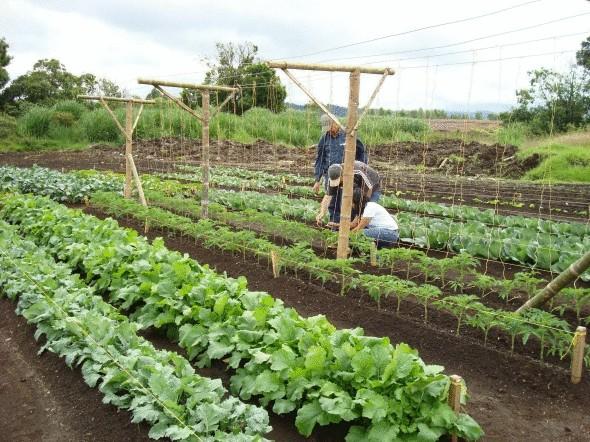
Tools
Appropriate, effective tools for growing a vegetable garden — these are tools that can work for a long time, without experiencing fatigue. If you only went to work and tired after twenty minutes, ask yourself whether those tools you have, maybe they too heavy? Self-respecting gardener always watching their equipment.
You will need the following tools:
1. Shovel with rounded blade and long handle. It is used for digging the earth. Also, perfectly suitable for removing perennial weeds and rhizomes.
2. Garden rakes. (20-centimeter rake is easier to use than a 30 - or 40-centimeter). Use a rake to level the soil and to form narrow ridges. The reverse side is used to break the clods.
3. Chopper with straight blade (sometimes called a manual propanol or manual pollinic) and not curved chopping. Use it only on the surface of the soil to destroy weeds by cutting their above-ground parts.
4. Bucket capacity 7-8 L. for mixing fertilizers.
5. Garden hose, end of which is securely wrapped in cloth. A rag wrapped around the hose, will prevent the formation of gullies in the soil. This will allow you to use the full water flow and will significantly speed up watering the garden.
6. Improvised fixture for fertilizer when feeding plants on narrow ridges. Thanks to this device you don't have to bend down and overwork the back and you can quickly fertilize the soil, passing along the ridges.
In order to manufacture such device nail empty tin can (preferably 450) by the end of the wooden planks cross-section of 5x5 cm and a length of 180 cm. or more long. If the wooden handle is positioned horizontally relative to the ground, then the Bank will be perpendicular to the handle (facing the open end facing up). It holds enough fertilizer to introduce a standard range of size 45 cm. x 9 m. Holding the handle inclined, start with one end of the ridge, and gently shaking, distribute the fertilizer. Go along the ridge, evenly distributing the fertilizer until you reach the other end. Again fill the jar with fertilizer and start to fertilize the next flower bed.
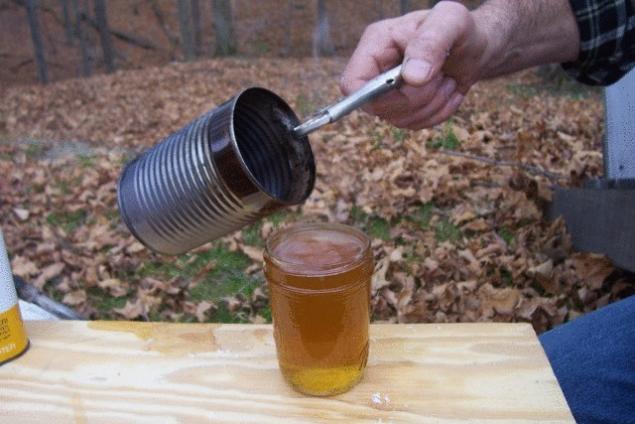
7. Probably you will also use razmerchikto ensure proper placement of plants. For different purposes use different razmerchik:
As for the materialsthat you will need to purchase the solve all method of vegetable that you choose. For vegetable growing on narrow ridges in natural soil need only a few simple hand tools, a cheap fertilizer and some materials for the supports when growing crops in vertical position. In addition, we will need seedlings and seeds. For vegetable boxes-ridges will need materials and tools needed for the construction of the boxes-ridges. If you want to automate the irrigation system or extend the growing season by building miniature greenhouses over the beds, you will also need plastic tubing and film. If you decide to grow your own seedlings in the greenhouse, you will need boxes for seedlings, potting mix, tools, containers and, of course, greenhouse-hotbed. The recommends advanced methods to make a list of necessary materials.

The time and laborrequired to create and maintain a vegetable garden on the advanced methods depend on what size plot you have planned, the state of the land you want to clear and prepare, and how you will obtain the seedlings. If you grow it yourself, you naturally save money, but spend more time.

Since the conditions for growing almost all different, the estimates are only approximate. For example, the area of the typical family garden with narrow ridges is 15 x 9 m. It is divided into 10 sections (narrow ridges) with the width of 45 cm and a length of 9 m aisles width of 105 cm. If you have a typical garden with narrow ridges, above the square, you must schedule 8-16 hours of work for cleanup of plots, construction of narrow ridges and arrangement of passages and tracks. Soil preparation and transplanting of seedlings will take another 12-16 hours. After plants are planted, watering, fertilizing and plant care , you should plan for 30 minutes a day (early morning). The harvest will require additional time, which depends on the nature of vegetables and their quantity, must be collected.

How to place a vegetable garden
1. Choose a Sunny place. All crops require sun, light, warmth and space to grow. The best sections are illuminated by the sun all day, but you can use the pad, illuminated by the sun from noon to the end of the day.
2. Select a smooth area. If you can find enough flat area, you will have less work. Ideal is a site with slight slope to the South. Steeper slopes can be used if to plant on the contour (the contour of the slope). Each individual site under a narrow ridge or under the drawer-I should be carefully aligned.
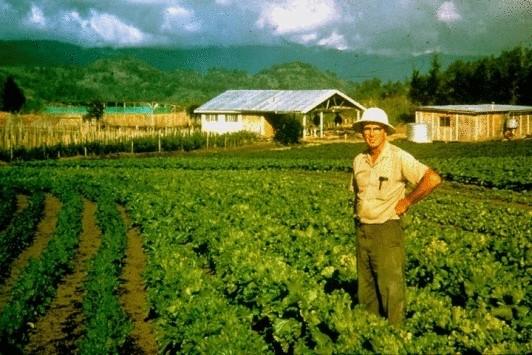
3. Avoid Northern slopes, because they are shaded, diffuse sunlight, and there is too cold. Avoid low spots with poor drainage. If the soil is saturated with moisture, the plants die from lack of oxygen.
4. Build the boxes-the ridge on high ground, so that nothing obstructed the flow of water. Avoid large trees and high fences, unless they are from the North of the plots. Culture, growing in the shade, poorly developed
5. Make sure that the nearby water. Water makes up over 80% of the weight of plants. Plants are thirsty.
6. Avoid open areaswhere strong wind blows, or build windbreaks. Wind can break the fragile, but very important for plant leaves, which can not affect the crop.
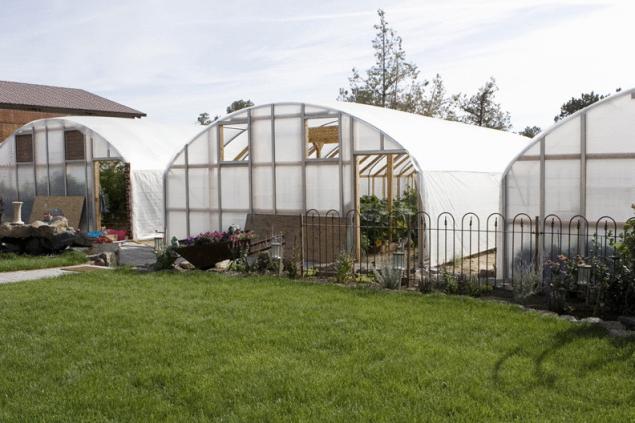
7. To protect the area from animals and unwelcome visitors, construct a fence from a grid of height 1.8-2.5 m.
8. Oddly enough, the former landfill, after removal of debris often become a popular choice for vegetable growing in boxes-ridges.
The correct time for planting in the garden depends on the climate of the area where it is located, and from variations in local weather conditions. If you live in an area with a cold climate the sooner you leave the plants in the open ground, the riskier this operation. Growing vegetables in areas with cold climates requires skill and special knowledge.
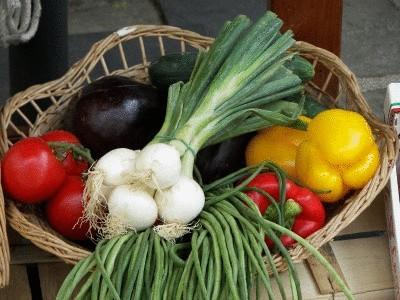
Usually the vegetation period as the number of days between the last frost in spring and first autumn. Usually these two dates mark the beginning and end of the period, when you can grow plants to full maturity outdoors. If you wish, you can stretch your growing season, extending it to frost using greenhouses and covered the narrow ridge and drawers-ridge. When planning a garden, find out when you can expect the last spring frost and first autumn frost. These dates will give you a General idea of when in your area, you can plant certain cultures and what types of crops to plant. The average date of last spring frost for your area is important but not the only instruction that will help you determine when to plant the plants in the garden; the proper planting time may depend on other factors.
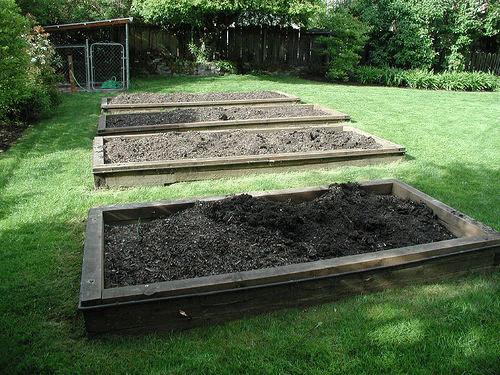
Pockets of freezing is low-lying sites where cold air accumulates. Some crops are sensitive to cold, such as strawberries should not be planted in such places. The lake, located next to a pond or even the highway with constant heavy traffic passing near the vegetable garden, can affect the temperature in the garden. If the garden is on a slope to the South, the plants can be planted earlier than in the case when the garden looking North.
Hardy vegetables tolerate frost and cold and can be planted in the garden for 3-6 weeks earlier than average last spring frost. Tender vegetables are very sensitive to frost and should be planted after the soil warms up. Hardy vegetables: carrots, rhubarb, broccoli, turnips, celery, peas, chard, kohlrabi, radishes, beets, horseradish, Jerusalem artichoke, leeks, rutabagas, shallots, onions, cabbage, lettuce, cauliflower, Brussels sprouts, asparagus (asparagus), cabbages, sprouts fodder. The following vegetables do not like cold, plant them in the average date of last spring frost and protect from further frost: mustard, beans, Bush corn, tomatoes, potatoes. The vegetables listed below can not tolerate frostand should be planted 2-3 weeks after the average date of last freeze: melons, pumpkins, beans twining (Lima), peppers, eggplant, zucchini, cucumbers, okra (okra), melons.

Deciding when to plant plants, remember that some plants prefer a cool weather while others love the heat. Culture, loving cool weather, such as cabbage, lettuce or peas, must Mature before the weather becomes too hot (above 32°C). Otherwise they'll wilt or produce seeds prematurely. Heat-loving crops such as melons or cucumbers will not grow or will give a poor crop, if the weather is too cold. The ideal temperature for the cultivation of vegetables from 24° to 32°C, the Plants virtually cease growing if the temperature falls below 10°C.
The growing cycle of the vegetables
The following schedule is typical of the cycle of growing vegetables in the home garden Dr. advanced methods in salt lake city, Utah.

Limit the size of the field, treat only the area which you will be able to handle well. A plot of land 15 by 10.5 m with narrow ranges can bring the following amount of vegetables if the entire vegetable garden will be planted with only one culture:
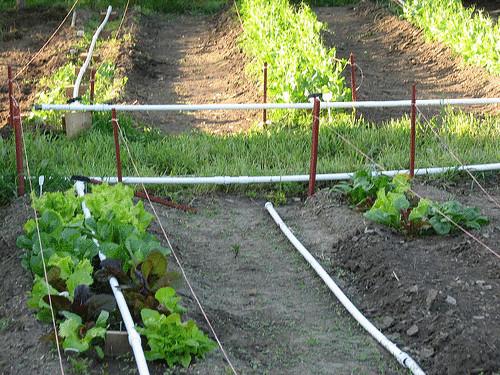
The next step after you have determined the location of plots, and decided what you want to grow — to plan where you will plant different crops. If you have a choice, Orient your narrow ridge from North to Southso that the shadows changed their position as the sun moves from East to West. Place low plants on the South side of taller crops. Thanks to that tall plants will not block light needed low-growing plants.
Source: /users/1
- Accuracy. The accuracy and thoroughness should be the rule. Be precise when choosing tools that measure out the fertilizer, water the plants and everything else that you do. Eliminate the guesswork, uncertainty, work at random.
- Productivity. Be aware that there are boundaries to your capabilities. Not in vain waste time, energy and money.
- Speed. Challenges in the cultivation of vegetables should be resolved quickly and with minimal number of errors. To work fast and efficiently to do as little physical movements. Don't create yourself extra work.
- Foresight. Be able to anticipate every next step or task. The work will be done successfully, if it will be preceded by a plan. Know what to do and when to do it.
- Neatness. To the cultivation of vegetables was a successful and productive vegetable garden needs to be clean, must be kept in order and looking beautiful.
- Consistency. The ability to uniform action. When plants receive uniform treatment and care, they grow uniformly and Mature at the same time. For example, if you grow beans, let's each plant beans in the same quantity of water and fertilizer.

Tools
Appropriate, effective tools for growing a vegetable garden — these are tools that can work for a long time, without experiencing fatigue. If you only went to work and tired after twenty minutes, ask yourself whether those tools you have, maybe they too heavy? Self-respecting gardener always watching their equipment.
You will need the following tools:
1. Shovel with rounded blade and long handle. It is used for digging the earth. Also, perfectly suitable for removing perennial weeds and rhizomes.
2. Garden rakes. (20-centimeter rake is easier to use than a 30 - or 40-centimeter). Use a rake to level the soil and to form narrow ridges. The reverse side is used to break the clods.
3. Chopper with straight blade (sometimes called a manual propanol or manual pollinic) and not curved chopping. Use it only on the surface of the soil to destroy weeds by cutting their above-ground parts.
4. Bucket capacity 7-8 L. for mixing fertilizers.
5. Garden hose, end of which is securely wrapped in cloth. A rag wrapped around the hose, will prevent the formation of gullies in the soil. This will allow you to use the full water flow and will significantly speed up watering the garden.
6. Improvised fixture for fertilizer when feeding plants on narrow ridges. Thanks to this device you don't have to bend down and overwork the back and you can quickly fertilize the soil, passing along the ridges.
In order to manufacture such device nail empty tin can (preferably 450) by the end of the wooden planks cross-section of 5x5 cm and a length of 180 cm. or more long. If the wooden handle is positioned horizontally relative to the ground, then the Bank will be perpendicular to the handle (facing the open end facing up). It holds enough fertilizer to introduce a standard range of size 45 cm. x 9 m. Holding the handle inclined, start with one end of the ridge, and gently shaking, distribute the fertilizer. Go along the ridge, evenly distributing the fertilizer until you reach the other end. Again fill the jar with fertilizer and start to fertilize the next flower bed.

7. Probably you will also use razmerchikto ensure proper placement of plants. For different purposes use different razmerchik:
- To lay out boxes for sowing seeds.
- To make the holes the same depth in the dive of seedlings.
- To place plants on narrow ridges or in boxes-ridges.
As for the materialsthat you will need to purchase the solve all method of vegetable that you choose. For vegetable growing on narrow ridges in natural soil need only a few simple hand tools, a cheap fertilizer and some materials for the supports when growing crops in vertical position. In addition, we will need seedlings and seeds. For vegetable boxes-ridges will need materials and tools needed for the construction of the boxes-ridges. If you want to automate the irrigation system or extend the growing season by building miniature greenhouses over the beds, you will also need plastic tubing and film. If you decide to grow your own seedlings in the greenhouse, you will need boxes for seedlings, potting mix, tools, containers and, of course, greenhouse-hotbed. The recommends advanced methods to make a list of necessary materials.

The time and laborrequired to create and maintain a vegetable garden on the advanced methods depend on what size plot you have planned, the state of the land you want to clear and prepare, and how you will obtain the seedlings. If you grow it yourself, you naturally save money, but spend more time.

Since the conditions for growing almost all different, the estimates are only approximate. For example, the area of the typical family garden with narrow ridges is 15 x 9 m. It is divided into 10 sections (narrow ridges) with the width of 45 cm and a length of 9 m aisles width of 105 cm. If you have a typical garden with narrow ridges, above the square, you must schedule 8-16 hours of work for cleanup of plots, construction of narrow ridges and arrangement of passages and tracks. Soil preparation and transplanting of seedlings will take another 12-16 hours. After plants are planted, watering, fertilizing and plant care , you should plan for 30 minutes a day (early morning). The harvest will require additional time, which depends on the nature of vegetables and their quantity, must be collected.

How to place a vegetable garden
1. Choose a Sunny place. All crops require sun, light, warmth and space to grow. The best sections are illuminated by the sun all day, but you can use the pad, illuminated by the sun from noon to the end of the day.
2. Select a smooth area. If you can find enough flat area, you will have less work. Ideal is a site with slight slope to the South. Steeper slopes can be used if to plant on the contour (the contour of the slope). Each individual site under a narrow ridge or under the drawer-I should be carefully aligned.

3. Avoid Northern slopes, because they are shaded, diffuse sunlight, and there is too cold. Avoid low spots with poor drainage. If the soil is saturated with moisture, the plants die from lack of oxygen.
4. Build the boxes-the ridge on high ground, so that nothing obstructed the flow of water. Avoid large trees and high fences, unless they are from the North of the plots. Culture, growing in the shade, poorly developed
5. Make sure that the nearby water. Water makes up over 80% of the weight of plants. Plants are thirsty.
6. Avoid open areaswhere strong wind blows, or build windbreaks. Wind can break the fragile, but very important for plant leaves, which can not affect the crop.

7. To protect the area from animals and unwelcome visitors, construct a fence from a grid of height 1.8-2.5 m.
8. Oddly enough, the former landfill, after removal of debris often become a popular choice for vegetable growing in boxes-ridges.
The correct time for planting in the garden depends on the climate of the area where it is located, and from variations in local weather conditions. If you live in an area with a cold climate the sooner you leave the plants in the open ground, the riskier this operation. Growing vegetables in areas with cold climates requires skill and special knowledge.

Usually the vegetation period as the number of days between the last frost in spring and first autumn. Usually these two dates mark the beginning and end of the period, when you can grow plants to full maturity outdoors. If you wish, you can stretch your growing season, extending it to frost using greenhouses and covered the narrow ridge and drawers-ridge. When planning a garden, find out when you can expect the last spring frost and first autumn frost. These dates will give you a General idea of when in your area, you can plant certain cultures and what types of crops to plant. The average date of last spring frost for your area is important but not the only instruction that will help you determine when to plant the plants in the garden; the proper planting time may depend on other factors.

Pockets of freezing is low-lying sites where cold air accumulates. Some crops are sensitive to cold, such as strawberries should not be planted in such places. The lake, located next to a pond or even the highway with constant heavy traffic passing near the vegetable garden, can affect the temperature in the garden. If the garden is on a slope to the South, the plants can be planted earlier than in the case when the garden looking North.
Hardy vegetables tolerate frost and cold and can be planted in the garden for 3-6 weeks earlier than average last spring frost. Tender vegetables are very sensitive to frost and should be planted after the soil warms up. Hardy vegetables: carrots, rhubarb, broccoli, turnips, celery, peas, chard, kohlrabi, radishes, beets, horseradish, Jerusalem artichoke, leeks, rutabagas, shallots, onions, cabbage, lettuce, cauliflower, Brussels sprouts, asparagus (asparagus), cabbages, sprouts fodder. The following vegetables do not like cold, plant them in the average date of last spring frost and protect from further frost: mustard, beans, Bush corn, tomatoes, potatoes. The vegetables listed below can not tolerate frostand should be planted 2-3 weeks after the average date of last freeze: melons, pumpkins, beans twining (Lima), peppers, eggplant, zucchini, cucumbers, okra (okra), melons.

Deciding when to plant plants, remember that some plants prefer a cool weather while others love the heat. Culture, loving cool weather, such as cabbage, lettuce or peas, must Mature before the weather becomes too hot (above 32°C). Otherwise they'll wilt or produce seeds prematurely. Heat-loving crops such as melons or cucumbers will not grow or will give a poor crop, if the weather is too cold. The ideal temperature for the cultivation of vegetables from 24° to 32°C, the Plants virtually cease growing if the temperature falls below 10°C.
The growing cycle of the vegetables
The following schedule is typical of the cycle of growing vegetables in the home garden Dr. advanced methods in salt lake city, Utah.
- Jan. Plan a vegetable garden. Whether you have narrow ridges or boxes-ridge? What tools will you need? Where you place the garden? Decide what crops you will grow. Some species are grown from seed, others planted seedlings. Calculate how much space will be required for planting.
- February. Sow the seeds of tomatoes and peppers in boxes for seedlings indoors or in a greenhouse. Calculate the sowing of seeds so that by the time of planting in unprotected lb plants was 12 weeks.
- March. In greenhouses or in the premises raspakirati seedlings of tomatoes and peppers in containers of larger size to give them more space for growth. Also in the greenhouse start to grow seedlings of the headed cabbages, cauliflower and broccoli from seed.
- April. When weather permits, visivite carrots, peas, radishes and green onions in open ground. Protect crops from night frosts.
- May. Planted seedlings of lettuce, cauliflower and broccoli, then tomatoes and peppers and will plant melons, cucumbers, pumpkins, eggplant, beans and corn.
- June-July. Planting seedlings vacated under early crops of the ridge. Take care of your grown plants.
- July-August. After the first harvest, if you want to get a second harvest, you can plant vegetables for a second time.
- September-October. Continue to grow crops under the film. Perekapyvayut expiring narrow beds without breaking lumps. Don't forget that the aisles are never perekapyvayut.

Limit the size of the field, treat only the area which you will be able to handle well. A plot of land 15 by 10.5 m with narrow ranges can bring the following amount of vegetables if the entire vegetable garden will be planted with only one culture:
- 850 lbs. of potatoes,
- 320 kg of beans,
- 3312 corn cobs,
- 936 cabbages with an average head weight of 1.3 kg., only 1.2 T.
- 936 heads of broccoli with the average head weighing 700 g. just 650 kg.
- 936 heads of cauliflower, with an average weight of 900 head, just 850 kg.
- 936 heads of lettuces with an average weight of 650 g. the head is just 640 kg.
- 320 lbs. of peas,
- 190 zucchini plants at 2.7 kg. of fruit per plant, just 520 kg.
- 570 plants melons cantaloupes at 2.7 kg. of fruits per plant, only 1.5 T.
- 380 plant watermelons for 8 kg. of fruit per plant, only 3.1 tons
- 380 plants banana pumpkin 9 lbs. per plant, only 3.4 T.
- 666 plant tomatoes at 3.6 kg. per Bush, only 2.4 T.
- 380 plants acorn pumpkins at 4.5 kg. per plant, only 1.7 T.

The next step after you have determined the location of plots, and decided what you want to grow — to plan where you will plant different crops. If you have a choice, Orient your narrow ridge from North to Southso that the shadows changed their position as the sun moves from East to West. Place low plants on the South side of taller crops. Thanks to that tall plants will not block light needed low-growing plants.
Source: /users/1
Tags
biodynamics
a method of advanced methods vegetable garden on the advanced methods course vegetable production for advanced methods
tools required
how to place the vegetable garden
the growing cycle of the vegetables by advanced methods Jacob mittleider
technology advanced methods
See also
The Human Brain Project: how do we know what's inside your brain?
How to correct the morning 45 minutes can make your day a success.
How to water the plants in the home garden
6 vegetables You can grow on a windowsill
To give birth to a son — does it matter
Romania in photographs from 1925 to 1984
How to create a product in the consumer electronics industry for a couple of weeks with a minimum budget
Lake Sarez
20 ways to make the bar
This naive and touching retro-futurism
















